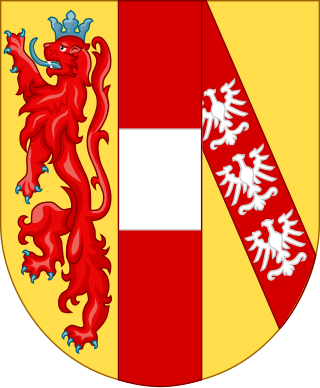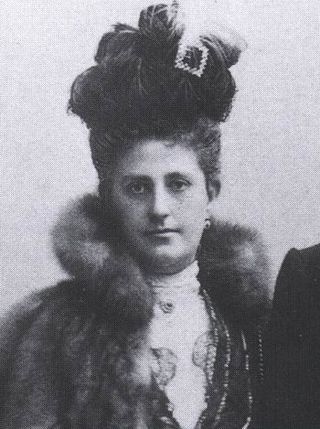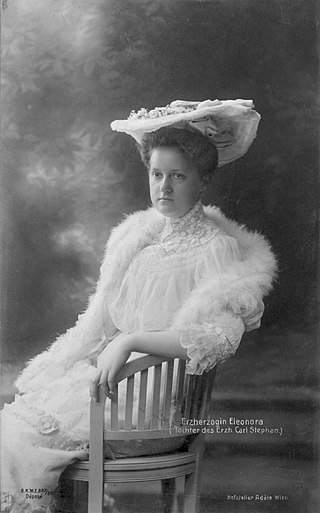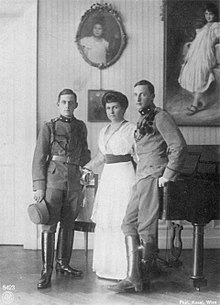
The Imperial Crypt, also called the Capuchin Crypt (Kapuzinergruft), is a burial chamber beneath the Capuchin Church and monastery in Vienna, Austria. It was founded in 1618 and dedicated in 1632, and located on the Neuer Markt square of the Innere Stadt, near the Hofburg Palace. Since 1633, the Imperial Crypt serves as the principal place of entombment for the members of the House of Habsburg. The bones of 145 Habsburg royalty, plus urns containing the hearts or cremated remains of four others, are here, including 12 emperors and 18 empresses. The visible 107 metal sarcophagi and five heart urns range in style from puritan plain to exuberant rococo. Some of the dozen resident Capuchin friars continue their customary role as the guardians and caretakers of the crypt, along with their other pastoral work in Vienna. The most recent entombment was in 2023.

The House of Lorraine originated as a cadet branch of the House of Metz. It inherited the Duchy of Lorraine in 1473 after the death without a male heir of Nicholas I, Duke of Lorraine. By the marriage of Francis of Lorraine to Maria Theresa of Austria in 1736, and with the success in the ensuing War of the Austrian Succession (1740–1748), the House of Lorraine was joined to the House of Habsburg and became known as the House of Habsburg-Lorraine. Francis, his sons Joseph II and Leopold II, and his grandson Francis II were the last four Holy Roman emperors from 1745 until the dissolution of the empire in 1806. The House of Habsburg-Lorraine inherited the Habsburg Empire, ruling the Austrian Empire and then Austria-Hungary until the dissolution of the monarchy in 1918.

The House of Habsburg-Este, also known as the House of Austria-Este and holder of the title of Archduke of Austria-Este, is a cadet branch of the House of Habsburg-Lorraine and also descends from the House of Este in the cognatic line. It was created in 1771 with the marriage between Ferdinand of Habsburg-Lorraine and Maria Beatrice d'Este, only daughter of the Duke of Modena, Ercole III d'Este. After the death of Ercole III in 1803, the Modena ruling branch of the Este family's male line ended, and the Habsburg-Este line subsequently inherited his possessions in what is now Italy.

The House of Habsburg-Lorraine originated from the marriage in 1736 of Francis III, Duke of Lorraine and Bar, and Maria Theresa of Austria, later successively Queen of Bohemia, Queen of Hungary, Queen of Croatia and Archduchess of Austria. Its members are the legitimate surviving line of both the House of Habsburg and the House of Lorraine and inherit their patrimonial possessions from their female line of the House of Habsburg and from the male line of the House of Lorraine.

Archduke Anton of Austria, Prince of Tuscany was a possible Carlist-Carloctavismo pretender to the Spanish throne and an Archduke of Austria by birth. In 1919, all titles of nobility and royalty were prohibited and outlawed in Austria. He was the seventh of ten children born to Archduke Leopold Salvator of Austria, Prince of Tuscany and Infanta Blanca of Spain, daughter of Infante Carlos, Duke of Madrid.

Archduke Karl Pius of Austria, Prince Royal of Hungary and Bohemia, Prince of Tuscany, known as Carlos Pío de Habsburgo-Lorena y de Borbón in Spanish, was a member of the Tuscan branch of the Imperial House of Habsburg and a Carlist claimant to the throne of Spain under the assumed name of "Carlos VIII". He was the tenth and youngest child of Archduke Leopold Salvator of Austria, Prince of Tuscany and Infanta Blanca of Spain.

Leo Karl Maria Cyril-Methodius Habsburg-Lorraine, Archduke of Austria was an Austro-Hungarian military officer, a member of the House of Habsburg-Lorraine. He was the fifth child and the second son of Archduke Charles Stephen of Austria and Archduchess Maria Theresia, Princess of Tuscany.

Archduke Karl Salvator of Austria, was a member of the Tuscan branch of the House of Habsburg.

Princess Maria Immaculata of Bourbon-Two Sicilies was fifth child and second-eldest daughter of Ferdinand II of the Two Sicilies and his wife Maria Theresa of Austria. Through her marriage to Archduke Karl Salvator of Austria, Maria Immaculata became an Austrian archduchess.

Archduke Franz Salvator of Austria was the son of Archduke Karl Salvator of Austria and Princess Maria Immacolata of Bourbon-Two Sicilies. He married Archduchess Marie Valerie in 1890, though, due to Marie Valerie's death in 1924, remarried in 1934 to Baroness Melanie von Riesenfels.

Archduchess Maria Theresa of Austria was a member of the House of Habsburg-Tuscany and Archduchess of Austria, Princess of Tuscany by birth. Maria Theresia was the eldest child and eldest daughter of Archduke Karl Salvator of Austria and his wife, Princess Maria Immaculata of Bourbon-Two Sicilies.

Archduke Leopold Salvator, Prince of Tuscany, was the son of Archduke Karl Salvator of Austria and Princess Maria Immaculata of Bourbon-Two Sicilies.

Infanta Blanca of Spain was the eldest child of Infante Carlos, Duke of Madrid, Carlist claimant to the throne of Spain and his wife Princess Margherita of Bourbon-Parma. Blanca was a member of the House of Bourbon and - according to the Carlists - an Infanta of Spain by birth. In 1889 she married Archduke Leopold Salvator of Austria, Prince of Tuscany. The couple had ten children. The family left Austria after the end of the Monarchy and finally settled in Barcelona. When the male line of Blanca's family died out at the death of her uncle, Alfonso Carlos, Duke of San Jaime, some of the Carlists recognized her as the legitimate heiress to the Spanish throne.

Archduchess Eleonora of Austria was a daughter of Archduke Charles Stephen of Austria and a first cousin of King Alphonso XIII of Spain. She was member of the Teschen branch of the House of Habsburg-Lorraine and an Archduchess of Austria and Princess of Bohemia, Hungary, and Tuscany by birth. She renounced to her titles upon her morganatic marriage to Alfons Kloss, the captain of her father's yacht. During World War II her sons served in the German army.

Archduke Rainer of Austria was a member of the House of Habsburg-Lorraine, a member of the Tuscan branch of the Imperial House of Habsburg, an Archduke of Austria and Prince of Tuscany by birth. He was the eldest son Archduke Leopold Salvator of Austria, Prince of Tuscany. He served as officer in the Austrian army during World War I. At the fall of the Habsburg dynasty, he remained in Vienna and worked for a time as taxi driver. He died unmarried at the age of 34 from blood-poisoning.

Archduchess Dolores of Austria‹See Tfd›German: Dolores Erzherzogin von Österreich-Toskana;(5 May 1891 – 10 April 1974) was a daughter of Archduke Leopold Salvator of Austria. She was member of the Tuscan branch of the Imperial House of Habsburg-Lorraine, an Archduchess of Austria and Princess of Tuscany by birth. After the dissolution of Austria-Hungary, she lived under reduced circumstances with her family in Spain, Austria, and Italy. She died unmarried.

Archduchess Immaculata of Austria‹See Tfd›German: Inmmaculata, Erzherzogin von Österreich-Toskana;(9 September 1892 – 3 September 1971) was a daughter of Archduke Leopold Salvator of Austria. She was member of the Tuscan branch of the Imperial House of Habsburg-Lorraine, an Archduchess of Austria and Princess of Tuscany by birth. After the dissolution of Austria-Hungary, she lived in exile, first in Barcelona and from the 1930s until the end of her life in Italy. In 1932, she married an Italian aristocrat, Igino Neri-Serneri. The couple remained childless.

Archduchess Maria Antonia of Austria‹See Tfd›German: Maria Antonia, Erzherzogin von Österreich-Toskana was a daughter of Archduke Leopold Salvator of Austria and Infanta Blanca of Spain. She was member of the Tuscan branch of the Imperial House of Habsburg-Lorraine, an Archduchess of Austria and Princess of Tuscany by birth. In 1919, after the dissolution of Austria-Hungary, she moved with her family to Spain. In 1924 she married Ramón de Orlandis y Villalonga, a Spanish aristocrat. When she became a widow during the Spanish Civil War, Archduchess Maria Antonia moved permanently to South America where she remarried.

Archduchess Assunta of Austria‹See Tfd›German: Assunta, Erzherzogin von Österreich-Toskana;(10 August 1902 – 24 January 1993) was the youngest daughter of Archduke Leopold Salvator of Austria and Infanta Blanca of Spain. She was a member of the Tuscan branch of the Imperial House of Habsburg-Lorraine, an Archduchess of Austria and Princess of Tuscany by birth. Born and raised in the twilight years of the Habsburg monarchy, Archduchess Assunta lived in exile in Barcelona, Spain after the dissolution of Austria-Hungary. She entered religious life in a convent in Barcelona, but was forced to leave it in 1936 due to disturbances during the Spanish Civil War. In 1939, she married Joseph Hopfinger, a Polish doctor. In 1942 the couple emigrated to the United States. Archduchess Assunta and her husband had two daughters, but they divorced in 1950. She moved to San Antonio, Texas where she had a variety of jobs living in anonymity until her death.

Archduke Franz Josef of Austria–Tuscany was the fourth son of Archduke Leopold Salvator of Austria, Prince of Tuscany and Infanta Blanca of Spain. At the fall of Habsburg monarchy he moved to Barcelona, where he became a naturalized Spanish citizen. He married morganatically twice and had a daughter from his second marriage. During World War II he lived in the United States, working in the forestry industry. In 1955 he returned to Austria. He inherited the Carlist pretensions to the Spanish throne of his brother Archduke Karl Pius and called himself Duke of Madrid. He died in 1975.




















